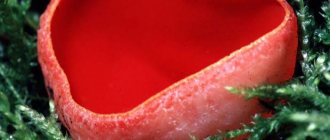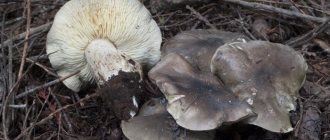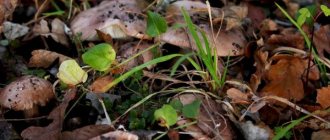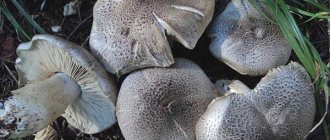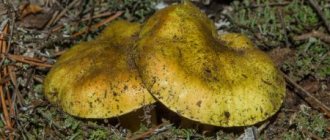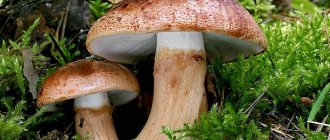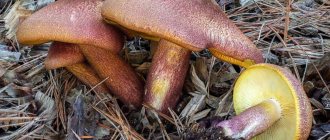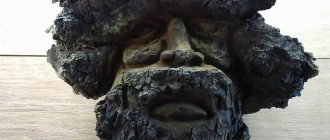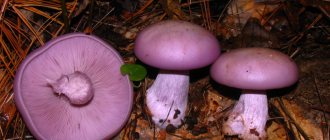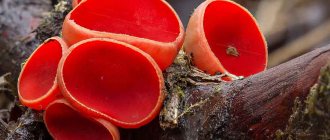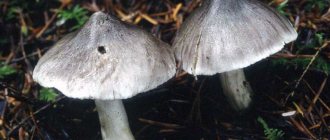Where crowded rows grow
Lyophyllumdecastes is a late mushroom. The fruiting period begins at the end of August and lasts until November. This species can be found in pine and deciduous forests, gardens, parks, meadows, roadsides, and herbs.
They grow mainly in numerous groups, trying to grow together with bases or legs. Places are chosen almost everywhere. Rarely grow alone. The fungus is common in the temperate zone. There are in Japan, the Far East, and Scandinavian countries.
Contraindications for use
Crowded row is prohibited for use in the following cases:
- age up to 12 years;
- pregnancy and lactation;
- diseases of the gastrointestinal tract;
- renal failure;
- liver failure.
If there are contraindications, complications arise, the external manifestations of which are similar to poisoning. The main symptoms are headache, dizziness, nausea, vomiting, loose stools. If these symptoms occur, the affected person’s stomach is washed. Then he must take special medications to remove toxins and normalize the composition of the microflora.
You should not eat mushrooms that grow near operating factories or busy highways. Fruiting bodies quickly absorb toxins from the environment.
What crowded rows look like
The photo clearly demonstrates the external signs of the crowded row, the description complements the characteristics of the mushroom.
The cap of the crowded row is large, reaching a diameter of 15 cm. In the first days, the shape resembles a pillow with a convex edge. As it matures, it becomes spread out, often losing its geometric regularity. The edge turns outward and becomes wavy. The surface of the upper part is gray-brown, off-white. The color in the center of the cap is somewhat brighter than along the edge. After rain or in a damp forest, the skin becomes sticky, slimy, and sometimes covered with dark scales. Often there are attached pieces of dirt on the cap.
The leg of the row is solid, long, and has a cylindrical shape. It grows from 4 to 11 cm. There is a noticeable thickening at the very base. Thickness 0.5-1.5 cm. The color of the lower part varies from white to gray. The surface is smooth. The pulp is dense. As a rule, mushrooms grow together with legs, so they are twisted, deformed, and fused.
The structure of the crowded row is fibrous and mealy. The pulp is light brown. It has a characteristic “row” smell. There is a hymenophore under the cap. White plates are located frequently. They can be attached or free. The spore powder is also white.
Growing at home and in the country
The methods of growing crowded rows are similar to the methods of growing champignons, but this process will still require certain skills. Features of lyophyllum cultivation:
- The room temperature should be 15 °C.
- The most optimal time for breeding rows is May, but autumn is also quite suitable.
- At the dacha, the mushroom is grown in beds, which should be covered with film from the scorching sun and precipitation.
Important! The soil on which the crowded row grows must be constantly moist.
To grow row trees in the country, you need to do the following:
- Mix the substrate with mycelium in a 1:2 ratio, cover with film to ensure high humidity.
- After 2–3 weeks, the crop must be covered with a 5 cm layer of damp soil.
- In a month, the first fruiting bodies will appear on the soil surface.
- After each harvest, it is necessary to make an additional layer of soil of half a centimeter.
- As soon as the temperature drops below 5 °C, the soil with the mycelium is covered with a cloth, and a layer of leaves or straw of at least 10 cm is placed on top.
How to plant rows indoors:
- Ensure the room has a constant temperature of 10–15 °C, an optimal level of humidity, good ventilation and lighting.
- If all conditions are met, after 3–4 weeks the first fruiting bodies will appear on the soil surface.
- You need to carefully harvest the crop and sprinkle the soil with a new layer.
Benefits and harm to the body
Mushrooms have beneficial, medicinal properties for the body. All thanks to the chemical composition of the fruiting bodies. Clitocin and fomecin destroy pathogenic microorganisms and cancer cells, performing the functions of an antibiotic. In addition, the crowded rows contain:
- proteins;
- cellulose;
- carbohydrates;
- fats;
- glucose, fructose;
- vitamins: A, B, C, D2, D7 and PP;
- minerals potassium, calcium, copper, sodium, phosphorus, manganese, zinc, iron, selenium;
- polysaccharides;
- amino acids;
- ergosterol.
It is believed that regular consumption of crowded rows increases immunity, has a positive effect on the gastrointestinal tract, stimulates the regeneration of liver cells, and promotes the removal of waste and toxins. The positive qualities of forest plants do not end there. They also activate the cardiovascular system, normalize blood sugar and heart rate.
Chemical analysis of the pulp determined the main properties of the mushrooms:
- antibacterial;
- anti-inflammatory;
- antiviral;
- antioxidant;
- immunomodulatory.
Important!
Crowded rows can cause diseases. Because mushrooms accumulate particles of heavy metals, pesticides, and mercury. They should not be used for pancreatitis, low acidity, or gallbladder dysfunction. Raw rows lead to intestinal disorders. Old copies do more harm than good.
Interesting Facts
- There are almost 2,500 species of mushrooms belonging to the family of mushrooms. They are called “rows” because they grow very crowded, most often in rows.
- Before any cooking method, these mushrooms must be boiled for 20 minutes.
- You should not eat raw lyophyllum as it may cause stomach upset.
- It is best to salt the rows in the fall, during this period the fruiting bodies are the most elastic and dense. For salting, you need to choose young specimens, as old ones can be tough.
Ryadovka crowded is a tasty, aromatic representative of the family of the same name. If you correctly identify and then process this mushroom, you can not only treat your family and friends with a unique dish, but also make delicious preparations for the winter.
Information sources
Aurel Dermek. Mushrooms. - Bratislava: Slovart, 1989 Z. A. Klepina and E. V. Klepina. Mushroom Picker's Guide. - Moscow: AST-PRESS, 2006 “Mushrooms”. Directory. / lane from Italian F. Dvin - Moscow: AST. Astrel, 2004
False doubles
Taking into account the characteristic way of growth, these mushrooms are difficult to confuse with other species. However, there are still doubles.
The row is fused. Cap size 3-8 cm. Cushion-shaped, convex shape. The edges are folded. The color of the upper part is white, yellow is less common. The center is somewhat darker. The pulp is light. The smell is weak. The plates are frequent and thin. The maximum height of the leg is 7 cm. The structure is dense, hard, fibrous. The legs are often crowded or deformed. They are found in the form of intergrowths of several plants. It begins to bear fruit in late summer. Grows in forest clearings, along roads. Select sparse areas of terrain. Prefers poor soils.
The mushroom is considered edible, but, according to people who have tried it, it is not tasty. Recently, during tests it was classified as an inedible, even poisonous type. Found in large groups.
The row is smoky, similar to the crowded row in a group way of growth. The color of the cap is grey. Its shape can be different: semicircular, flattened, depressed. It all depends on the age of the plant. The pulp is white, hard, dense. When mature, it acquires a loose structure. There is a light fruity-floral scent. The leg is thick, club-shaped. The color is smoky gray.
This species grows in mixed forests, spruce forests, and gardens. The fruiting period begins in August-October. When it appears, it forms circles and rows.
The mushrooms can be confused with other plate-like varieties that grow in clumps. Among them are the crowded collibium, meadow honey fungus, and armored row.
Definitioner
rare (rare smell)
In mycology, rare smell, English. "raphanoid" is interpreted very loosely and often refers to any smell of raw root vegetables, including potatoes, i.e. not necessarily as sharp, pungent and fresh as black or white radish.
Basidia (Basidia)
Lat. Basidia. A specialized structure of sexual reproduction in fungi, unique to basidiomycetes. Basidia are terminal (end) elements of hyphae of various shapes and sizes, on which spores develop exogenously (outside).
Basidia vary in structure and method of attachment to hyphae.
Based on the position relative to the axis of the hyphae to which they are attached, three types of basidia are distinguished:
Apical basidia are formed from the terminal cell of the hypha and are located parallel to its axis.
Pleurobasidia are formed from lateral processes and are located perpendicular to the axis of the hypha, which continues to grow and can form new processes with basidia.
Subbasidia are formed from a lateral process turned perpendicular to the hyphal axis, which stops growing after the formation of one basidium.
Based on morphology:
Holobasidia are single-celled basidia, not divided by septa (see Fig. A, D).
Phragmobasidia are divided by transverse or vertical septa, usually into four cells (see Fig. B, C).
By type of development:
The heterobasidium consists of two parts - the hypobasidium and the epibasidium developing from it, with septations (see Fig. C, B) or without them (see Fig. D).
Homobasidia is not divided into hypo- and epibasidia and in all cases is considered to be holobasidium (Fig. A).
The basidium is the site of karyogamy, meiosis, and the formation of basidiospores. Homobasidy, as a rule, is not functionally divided, and meiosis follows karyogamy. However, the basidia can be divided into probasidium, the site of karyogamy, and metabasidium, the site of meiosis. Probasidium is often a resting spore, for example in rust fungi. In such cases, the probasidium germinates into a metabasidium, in which meiosis occurs and on which basidiospores are formed (see Fig. E).
See Karyogamy, Meiosis, Hypha.
Pileipellis
Lat. Pileipellis, skin - a differentiated surface layer of the cap of agaricoid basidiomycetes. The structure of the skin in most cases differs from the inner flesh of the cap and may have a different structure. The structural features of pileipellis are often used as diagnostic characters in descriptions of fungal species.
Based on their structure, they are divided into four main types: cutis, trichoderma, hymeniderma and epithelium.
See Agaricoid fungi, Basidiomycete, Cutis, Trichoderma, Hymeniderma, Epithelium.
Hymeniderma
A type of cap skin, consists of nonseptate elements located more or less perpendicular to the surface and laid at the same level, resembling the hymenial layer.
Lat. Hymeniderm.
It is divided into trichohymeniderma, euhymeniderma, and epithelioid hymeniderma.
There is also a transitional structure of the skin from the hymeniderm to the epithelium. (A mixture of round cells, characteristic of the epithelium, but located in one layer, and pear-shaped cells, characteristic of the hymenidermis, lying at the same level.)
See Hymenial layer, Trichohymeniderm, Euhymeniderm, Epithelioid hymeniderm, Epithelium, Septa.
Collection rules
It is better to go to the forest early in the morning. In the evening the search will be difficult due to poor visibility. Cut the legs with a knife under the base so that the mycelium remains in the ground. A basket, bag, or bucket are suitable for harvesting. Forest plants have dense pulp, so they do not break during transportation. Each specimen should be cleaned of sand and dry debris.
You should be extremely careful not to confuse the edible variety with its outwardly similar false counterparts. It is recommended to look again at home and sort the gifts of the forest. Young mushrooms are suitable for further processing.
About edibility
It would be unfair to call the soap bark frankly poisonous. It is almost impossible to be poisoned to death by it. But the mushroom has an unpleasant feature: it smells distinctly and brightly of laundry soap. Even those from Soviet times. That is why the soap row is considered inedible. There is still a recipe for its preparation: cook only with other, more pleasant gifts of the forest, add small quantities to a common pile, and before salting, cook in three or four waters, mercilessly draining them.
However, this doesn't help much. The soapy “aroma” is too persistent. Some mushroom pickers are even sure that it only intensifies when cooked.
In addition, there is information that the pulp itself tastes bitter. It is partially eliminated during cooking. But accompanied by a distinct aroma, eating mushrooms still does not bring pleasure.
How to prepare crowded rows
This species is classified as conditionally edible, so it is allowed to be consumed only after heat treatment. Be sure to boil the mushrooms for 15 minutes in clean water. Thus, all hazardous substances are destroyed.
Recipe for making crowded row:
- Clean, rinse under running water.
- Place in a container and add salt.
- Cook for 40 minutes over medium heat.
- Strain.
- Add vegetable oil, onion, cut into half rings.
This species can also be salted, fried, pickled, like other edible plate varieties. The taste of the row is often compared to oyster mushrooms.
Cooking recipes
Cooking
Place a pan of water on the fire and pour a little vinegar into it. Boil for 10 minutes. Then the liquid is drained, the mushrooms are placed in a colander and the same procedure is performed a second time. The rows are boiled in new water with the addition of vinegar for another 20 minutes. A peeled onion will help get rid of the unpleasant odor; it is thrown into the pan 10 minutes before the end of the procedure. Ready mushrooms are washed with cold water.
After this they can be salted. It is contraindicated to eat in large quantities. This may lead to poisoning.
How to salt a mushroom with garlic and horseradish?
For 5 kg of rows you will need:
- 200 g table salt;
- horseradish leaves (to taste);
- black currant leaves (2 pieces for each jar);
- garlic cloves (2-3 for each jar).
Cleaned, washed and free of soapy smell, mushrooms are placed in sterilized jars. First, half the seasonings and salt are placed in them. Cover with the remaining portion of the ingredients. The jars are rolled up and put in a cool place. The product can be used after 45 days.
Description
The fruiting body is large.
The cap is 4-10 (12) cm in diameter, fleshy, brittle, in mature mushrooms - uneven, with a wavy or lobed edge; often appears longitudinally striped. In young mushrooms the cap is hemispherical with a curled edge, later it is convex-spread with a curved or even raised edge, less often it is spread out or slightly concave. In one splice there may be caps of different sizes and shapes. The skin on the cap is smooth (occasionally with small flat dark scales in the center), in wet weather it is moist and slightly sticky. The color of the cap is off-white, gray or gray-brown, lighter at the edges; Lightens with age; does not change when pressed.
The flesh of the cap is dense, elastic, fibrous, light or grayish-brown, with a faint floury (“row”) smell and a weak but pleasant taste.
relatively frequent, thick, 0.5 cm wide, with smooth edges, slightly drooping or attached to a tooth, in maturity sometimes lags behind the stem; off-white or yellowish (darkens when pressed).
Leg 3-8 (10) cm long and 0.5-2.5 cm in diameter, dense, solid, cylindrical or slightly swollen, often tuberous-thickened downward; The plates are white, grayish-brown towards the base. The surface of the stem is smooth, flaky-mealy at the top; the pulp is longitudinally fibrous. In relation to the cap, the leg is sometimes eccentric. Often the legs of a group of lyophyllums are fused at the bases.
Spore powder is white. Spores are 5-7 × 5-6 µm, smooth, broadly ellipsoid, colorless, non-amyloid.
Marinating mushrooms
Pickling poplar rows: recipes for the winter
The spongy (tubular) layer and pulp of the caps of too large and overripe poplars “spread” during heat treatment, losing their shape and making the marinade cloudy, so only whole, healthy (not wormy), young and strong mushrooms. The smallest specimens can be used whole, but for the rest it is better to separate the stems from the caps and cut into small pieces of approximately the same size.
It is recommended to immediately immerse the chopped onions in cold water with the addition of salt and citric acid (at the rate of 1 teaspoon of salt and 2 g of lemon per 1 liter of water) and boil, otherwise their flesh will quickly darken in the air. Usually the mushrooms are cooked for 25-30 minutes until they begin to settle to the bottom of the pan. The foam that forms during cooking must be removed with a slotted spoon. We will consider further preparation and methods of canning step by step in simple recipes.
Marinated “traditional” obabki
This recipe is perhaps the most popular, suitable for pickling almost any type of mushroom. Thanks to a minimal set of spices and herbs, obabki retain their natural taste and aroma, acquiring a soft, elastic texture.
Number of servings/volume: 2-2.5 l
Ingredients:
- boiled mushrooms – 2 kg;
- water – 1 l;
- rock salt – 40-50 g;
- table bite, 9% – 100-150 ml;
- allspice (peas) – 7-10 pcs.;
- black pepper (peas) – 10-15 pcs.;
- bay leaf – 4-5 pcs.
If desired, sugar (20-40 g), cloves and cinnamon in small quantities are also added to the marinade.
Step-by-step cooking technology:
- Carefully place the boiled mushrooms in a colander and leave them to drain.
- Prepare the brine. Pour water into a pan, heat it, add salt, sugar, pepper and bay leaf. Boil.
- Place the mushrooms in boiling brine and simmer over low heat, stirring, for 10-15 minutes. Pour in vinegar 2-3 minutes before the end of cooking.
- Sterilize jars and lids.
- Divide the mushrooms into 2/3-3/4 of the volume of the jars, fill them with marinade (just below the top of the neck), cover with lids.
- Place the filled jars in a saucepan with hot water and sterilize for 15-30 minutes (depending on the volume of the jars) at low boil.
- Seal the jars tightly by rolling up (screwing) the lids. Turn upside down and wrap in a warm blanket to cool slowly.
Cooled jars can be stored at home: in the pantry, kitchen cabinet or on the balcony. The main thing is that the right place is chosen - dark, dry and cool. The shelf life of sterilized canned mushrooms is about 12 months. When serving, pickled mushrooms are sprinkled with chopped onions, chopped herbs, garlic and seasoned with vegetable oil. It turns out very tasty!
Obabki marinated without vinegar
Fans of “soft” marinades will certainly like mushrooms prepared with the addition of citric acid instead of vinegar. The only “but” is that they need to be stored in the cold, at temperatures up to +8 ℃ and no more than 6-8 months.
Number of servings/volume: 1.5-2 l
Ingredients:
- fresh boletus and boletus – 2 kg;
- mushroom broth - 1 l (for marinade);
- rock salt – 1.5-2 tbsp. l.;
- sugar – 3-4 tbsp. l.;
- citric acid – 1 tsp;
- garlic – 5-6 cloves;
- allspice (peas) – 10-15 pcs.;
- bay leaf – 3-4 pcs.;
- dill, umbrellas – 3-4 pcs.;
- vegetable oil – 150-200 ml.
Preparation:
- Rinse the peeled and chopped mushrooms thoroughly. Place in a saucepan, add a small amount of water and put on fire. Bring to a boil, add salt and simmer over low heat for 15-20 minutes, stirring constantly and skimming off the foam.
- Let the mushrooms cool in the broth, transfer them to a colander, and carefully strain the broth through cheesecloth. To prepare the marinade you will need approximately one liter of mushroom broth (the rest can be used by adding to soups or sauces).
- Pour the marinade broth into a saucepan, add salt (to taste), sugar and citric acid. Boil.
- Place the mushrooms in the boiling marinade and simmer for 5-7 minutes.
- Peel the garlic and cut the cloves into slices or slices.
- Place several pieces of garlic, an umbrella of dill, a bay leaf and 3-5 peas of allspice into each of the prepared jars (sterilized, dry).
- Place mushrooms in jars along with marinade. Gently pour a few tablespoons of hot vegetable oil on top.
- Close the jars tightly with nylon (polyethylene) lids, after dipping them in boiling water. Leave at room temperature to air cool.
The cooled workpiece should be placed in the refrigerator or cellar. Marinated obabki are good in their “pure” form - as an independent delicious snack; they are also added to other dishes: salads, soups, side dishes, fillings for pies.
